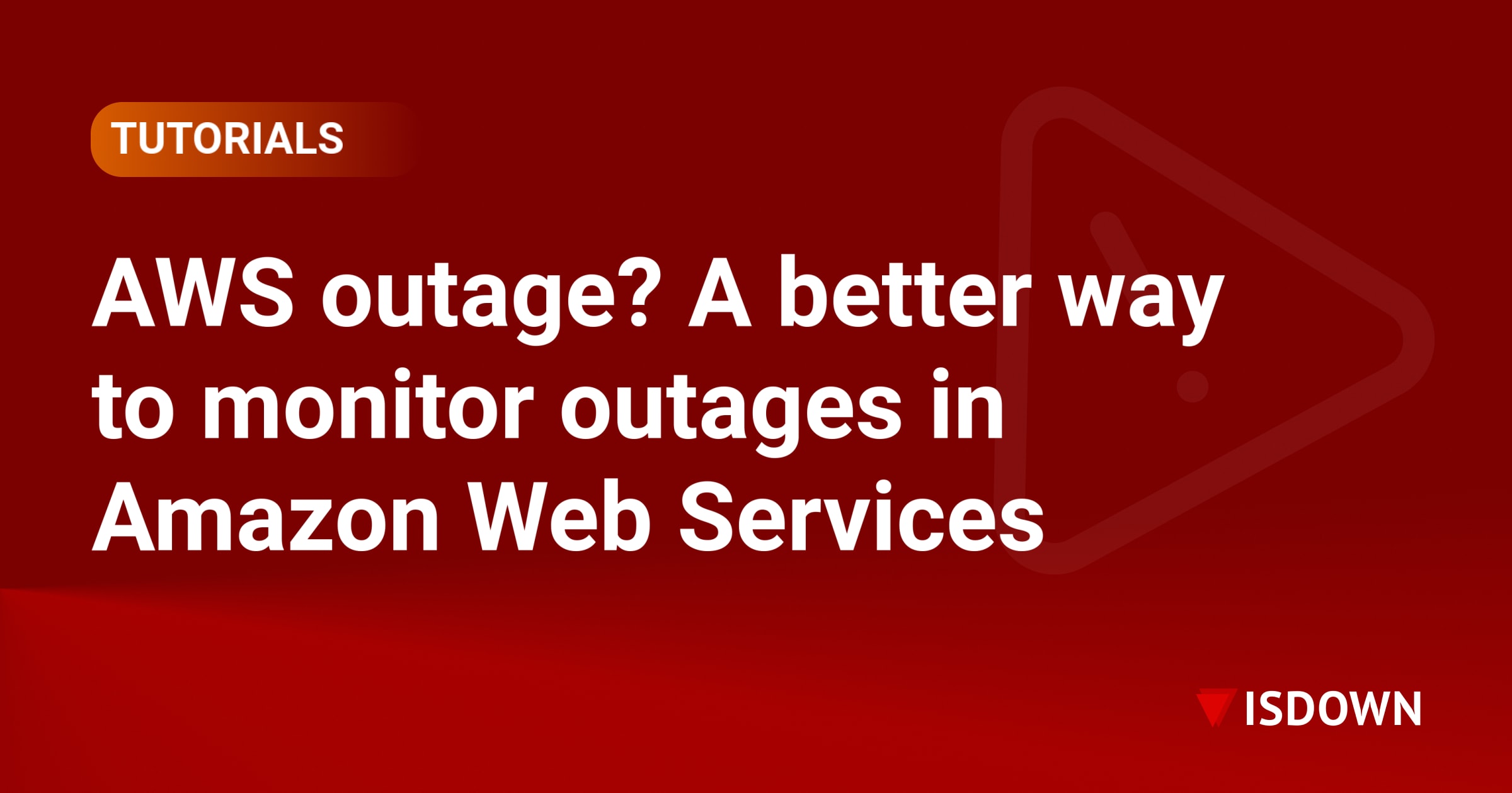What Is an API Outage? Why It Happens and How to Avoid It

APIs are a big part of how modern applications or services work. They act as bridges, allowing systems to talk to each other and share data. Whether it's logging into an app or making an online payment, an application programming interface helps make that process smooth.
But what happens when an API suddenly stops working? Even a short outage can cause a disruption. It can break features, delay operations, and impact users and businesses alike. These failures may seem small at first, but their effects can grow quickly.
In this article, we'll look at what an API outage is, what causes it, how API outages impact businesses, and what steps you can take to avoid API outages, especially with smart monitoring tools.
What Is an API?
An API, or application programming interface, is a set of rules that lets two applications or services talk to each other. It helps them transfer data, make requests, and work together without needing to understand how each other's systems are built.
Think of it like a waiter in a restaurant. You give the waiter your order. The waiter takes it to the kitchen. Once the meal is ready, the waiter brings it back to your table. In this example:
- You are one system
- The kitchen is another system
- The API is the waiter that passes messages between them
Modern APIs use formats like REST. These APIs are often versioned, well-documented, and easy for developers to use. Because of this, they are used in all kinds of businesses, from small apps to global platforms. Many companies depend on APIs to keep services running, share information, and connect to third-party tools.
What Happens During an API Outage?
An API outage happens when the API doesn't respond or stops working. It means the "waiter" can't deliver the message, so the systems can't communicate. This may happen for a few seconds, minutes, or even hours, depending on the issue.
When an API is unavailable, users may see errors like:
- Broken logins
- Failed payments
- Missing data
- Parts of the website or app are going offline
These problems can create a serious service disruption. For example, a server might crash, or an update might introduce a bug. If the endpoint is down, users get blocked from using important features.
Many APIs promise a certain level of uptime in their Service Level Agreements (SLAs). A common SLA is 99.9% uptime, which allows only about 43 minutes of downtime each month. If an API fails more than that, it breaks the agreement and can lead to revenue loss or other business issues.
What Causes an API Outage?
There are many possible causes of API outages. Some are technical issues. Others are simple mistakes made by people. This section explains the most common reasons an API might fail.
Code and Application Errors
APIs are built with code. If that code has a bug, it can break the functionality. A simple error in logic, an untested update, or a missing edge case can cause the whole API to malfunction.
Sometimes, new features are added without proper testing. If these changes fail in production, the API can go offline. This is why it is important to review and test every update before release. Other problems include memory leaks, crashes, or using outdated libraries. These issues may seem small, but can quickly grow into a full api outage.
Infrastructure Failures
An API depends on its server and hardware. The API will stop responding if the server is overloaded, out of memory, or just stops working.
Many APIs today run in containers. If a container crashes and doesn't restart, that part of the system becomes unavailable. Without a backup system or failover plan, the entire service may go down. Even cloud services can have problems. If a third-party hosting provider has issues, your API may experience downtime, even if your own code is fine.
Network and Routing Issues
APIs need a strong network to stay online. Users will see errors or delays if the system loses internet access or can't route requests correctly. Poor routing or a broken api gateway can block traffic or send it to the wrong place. Without high availability features like load balancing or multiple paths, a single network failure can bring down the API.
Security Vulnerabilities and Attacks
Hackers often look for weak APIs. If an API isn't protected, it can face attacks like DDoS, which flood the system with traffic and take it offline. Other attacks include sending a harmful payload or trying to bypass authentication. These actions can expose sensitive data or force the API to shut down for safety.
Configuration and Human Errors
Sometimes, outages happen because someone made a mistake. A wrong setting, skipped test, or change made too quickly can cause an API to fail. One small change can lead to a significant disruption without good configuration checks or a rollback plan.
How API Outages Affect Businesses
Let's break down the key areas where these disruptions cause the most harm.
Financial and Operational Losses
An api outage can lead to a direct loss of revenue. Businesses miss out on sales if users can't make purchases or access services. For companies that rely on APIs to handle payments or bookings, even a short outage can cause a big drop in income.
There are also costly internal effects. Teams may waste time trying to resolve the problem. Support tickets increase. Delays in service can affect customers, partners, and vendors.
Some businesses have Service Level Agreements (SLAs) that promise a certain level of uptime. If they break that promise, they may need to issue refunds or pay penalties.
Damage to Reputation and Customer Trust
An API going offline doesn't just stop features; it affects how people view your business. When users face errors, delays, or broken services, they lose trust.
This is a major problem in competitive industries. Customers may switch to another service that feels more reliable. If the service disruption becomes public or spreads on social media, the damage to a business's reputation can grow fast.
Service Disruption and User Frustration
APIs power features people use every day. If an endpoint fails, it may block logins, checkout pages, or live data from loading. These moments feel like the app is "broken," even if it's just the api behind the scenes.
Users may give up, complain, or leave altogether. If a disruption happens often, people may stop using the service entirely.
Security and Data Risks
An api outage can create a window where systems are more open to attack. During recovery, teams may change settings, disable protections, or reroute traffic in unsafe ways.
Hackers may take advantage of the confusion to send fake requests, inject harmful payloads, or bypass weak authentication. These risks make monitoring and strong security even more important during and after an outage.
How to Prevent API Outages
API failures can happen, but many of them are avoidable. With the right tools and habits, you can minimize risks, respond faster, and mitigate the effects.
Monitor APIs with Real-Time Alerts: Use monitoring tools that provide real-time data and alerts. These help your team respond quickly to performance issues or downtime. Not just your APIs, but also monitor the external services your system relies on.
Conduct Regular Testing: Run load and stress tests to uncover weak spots before users do. Testing helps you prepare for traffic spikes and improves system reliability by showing what needs fixing or optimizing.
Use Containers and Orchestration: Containers isolate services so they're easier to manage or restart. Tools like Kubernetes add automation, reroute traffic, and ensure system stability, even during high demand or failures.
Harden Security and Apply Rate Limiting: Protect APIs with SSL, secure gateways, and authentication. Add rate limiting to control traffic and block abuse, reducing the risk of crashes from overload or attacks.
Deploy with Caution: Avoid breaking your system during updates by using canary deployments and testing in staging environments. This way, you catch issues early and limit the impact of bad code.
Maintain a Robust Bug Tracking System: A good bug tracking system helps teams spot, sort, and resolve problems fast. Use observability tools and track releases to fix errors and keep key services running smoothly and quickly.
Why a Status Page Aggregator Is Especially Valuable for API Outage Mitigation
No tool can fully prevent a third-party API from going down. However, businesses can stay informed and respond quickly with a status page, which acts as the main communication channel during API outages. While it won't fix the issue, it helps minimize the damage by keeping users updated in real time.
A status page aggregator collects updates from official service pages and combines them with real-time reports from users. Instead of checking dozens of sites manually, teams see everything in one dashboard. This saves time and reduces the risk of missing something important.
Unlike traditional monitoring tools that only watch your internal systems, an aggregator focuses on external services. These tools help businesses that rely on cloud apps, platforms, or APIs from other providers.
For example, IsDown tracks over 3,800 services and alerts teams when a service experiences an outage, often before the vendor even updates their own page. By cutting through noise and sending focused alerts, it helps your team act faster and stay organized.
Key Benefits of a Status Page Aggregator:
- Reduce downtime impact by spotting problems early
- Respond before users experience issues
- Keep stakeholders informed through internal or public updates
- Hold vendors accountable using past incident records
Compared to siloed tracking or waiting on support tickets, an aggregator gives your technical team a clear view of what's really happening and what needs attention.
For any company that depends on cloud tools, APIs, or outside services, a status page aggregator is a simple yet powerful way to strengthen your API downtime response strategy.
Conclusion
An API outage isn't just a technical problem; it's a business problem. When an API goes down, it can disrupt services, create backend issues, frustrate users, and result in lost revenue. The effects can be serious, whether caused by a bug, a failed configuration, or a third-party failure.
That's why proactive steps matter. From monitoring and alert systems to stress testing and security controls, teams need to prepare before a failure happens, not just react afterward. Preventing downtime, or at least minimizing its impact, is key to protecting your systems and your brand.
If your business depends on external services or cloud tools, tools like IsDown can make a real difference. With real-time alerts, status page aggregation, and early incident detection, IsDown helps teams stay informed and ready before users even notice there's a problem.
Start monitoring smarter and reduce the chaos of third-party outages with IsDown.
Frequently Asked Questions
What Does Missing API Mean?
A "missing API" typically means the application is unable to find or connect to the API it needs. This can result in broken features or failed data requests.
What Is API Abuse?
API abuse is the misuse of an API beyond its intended purpose. It includes actions like excessive data scraping, unauthorized access, or injecting malicious code to disrupt services.
What Does API Issues Mean?
API issues refer to any problems or errors that occur during communication between applications and an API. These can impact data exchange, performance, or functionality.
What Is an Example of an API Error?
Common API errors include:
- 404 Not Found: The requested endpoint or resource doesn't exist
- 400 Bad Request: The request is malformed or invalid
- 401 Unauthorized: Missing or incorrect API key
- 403 Forbidden: No permission to access the resource
- 500 Internal Server Error: A problem occurred on the API server side
 Nuno Tomas
Founder of IsDown
Nuno Tomas
Founder of IsDown





